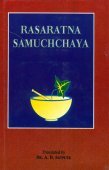Am, Aṃ, Ām: 17 definitions
Introduction:
Am means something in Buddhism, Pali, Hinduism, Sanskrit, Marathi, biology, Tamil. If you want to know the exact meaning, history, etymology or English translation of this term then check out the descriptions on this page. Add your comment or reference to a book if you want to contribute to this summary article.
Images (photo gallery)
(+105 more images available)
In Hinduism
Vyakarana (Sanskrit grammar)
Source: Wikisource: A dictionary of Sanskrit grammarAṃ (अं).—(ं) nasal utterance called अनुस्वार (anusvāra) and written as a dot above the vowel preceding it. cf. स्वरमनु संलीनं शब्द्यते इति (svaramanu saṃlīnaṃ śabdyate iti); it is pronounced after a vowel as immersed in it. The anusvāra is considered (l) as only a nasalization of the preceding vowel being in a way completely amalgamated with it. cf. T. Pr. V. 11,31; XV. 1; XXII. 14 ; (2) as a nasal addition to the preceding vowel, many times prescribed in grammar as nuṭ (नुट् (nuṭ)) or num (नुम् (num)) which is changed into anusvāra in which case it is looked upon as a sort of a vowel, while, it is looked upon as a consonant when it is changed into a cognate of the following consonant (परसवर्ण (parasavarṇa)) or retained as n (न् (n)). cf. P. VIII.4.58; (3) as a kind cf consonant of the type of nasalized half g(ग् (g)) as described in some treatises of the Yajurveda Prātiśākhya: cf also R. Pr.1.22 V.Pr.14.148-9. The vowel element of the anusvāra became more prevalent later on in Pali, Prkrit, Apabhraṃśa and in the spoken modern languages while the consonantal element became more predominant in classical Sanskrit.
--- OR ---
Āṃ (आं).—Indeclinable आ (ā) pronounccd nasalized, e. g. अभ्र आँ अपः (abhra āṃ apaḥ) M. Bh. I.3.2.
--- OR ---
1) Ām (आम्).—Augment आ (ā) prescribed in connection with the words चतुर् (catur) and अनडुह् (anaḍuh) before the case-affixes called सर्वनामस्थान (sarvanāmasthāna); cf. चतुरनडुहोराम् उदात्तः (caturanaḍuhorām udāttaḥ) P.VII.1.98;
2) Ām.—The affix आम् (ām) added before लिट् (liṭ) or a perfect termination by rules कास्प्रत्ययादाम् अमन्त्रे लिटि (kāspratyayādām amantre liṭi) and the following (P. III 1.35-39), as for instance, in कासांचक्रे, ऊहांचक्रे, दयांचक्रे, जागरांचकार, विभयांचकार (kāsāṃcakre, ūhāṃcakre, dayāṃcakre, jāgarāṃcakāra, vibhayāṃcakāra) etc.;
3) Ām.—Geni. pl. caseaffix आम् (ām) as in दृषदाम्, शरदाम् (dṛṣadām, śaradām), with न् (n) prefixed in रामाणाम् (rāmāṇām) etc., and with स् (s) prefixed in सर्र्वेषाम् (sarrveṣām) etc.;
4) Ām.—loc. sing. case-affix आम् (ām) substituted for इ (i) (ङि (ṅi)); cf. ङेराम् नद्याम्नीभ्यः (ṅerām nadyāmnībhyaḥ) P.VI.4.116.

Vyakarana (व्याकरण, vyākaraṇa) refers to Sanskrit grammar and represents one of the six additional sciences (vedanga) to be studied along with the Vedas. Vyakarana concerns itself with the rules of Sanskrit grammar and linguistic analysis in order to establish the correct context of words and sentences.
In Buddhism
Tibetan Buddhism (Vajrayana or tantric Buddhism)
Source: OSU Press: Cakrasamvara SamadhiAṃ (अं) is the bīja associated with Arbuda, according to the Cakrasaṃvara-maṇḍala or Saṃvaramaṇḍala of Abhayākaragupta’s Niṣpannayogāvalī, p. 45 and n. 145; (Cf. Cakrasaṃvaratantra, Gray, David B., 2007).—The Cakrasaṃvara mandala has a total of sixty-two deities. [...] Three concentric circles going outward, the body, speech and mind wheels (kāya-vāka-citta), in the order: mind (blue), speech (red), and body (white), with eight Ḍākinīs each in non-dual union with their Ḍākas, "male consorts".
Associated elements of Mahānāśā and Vikaṭadaṃṣṭriṇa:
Circle: kāyacakra (mind-wheel) (blue);
Ḍākinī (female consort): Mahānāśā;
Ḍāka (male consort): Vikaṭadaṃṣṭriṇa;
Bīja: aṃ;
Body-part: occiput;
Pīṭha: Arbuda;
Bodily constituent: māṃsa (muscle);
Bodhipakṣa (wings of enlightenment): citta-ṛddhipāda (power of thought).

Tibetan Buddhism includes schools such as Nyingma, Kadampa, Kagyu and Gelug. Their primary canon of literature is divided in two broad categories: The Kangyur, which consists of Buddha’s words, and the Tengyur, which includes commentaries from various sources. Esotericism and tantra techniques (vajrayāna) are collected indepently.
Biology (plants and animals)
Source: Wisdom Library: Local Names of Plants and DrugsAm [आम] in the Hindi language is the name of a plant identified with Mangifera indica from the Anacardiaceae (Cashew) family. For the possible medicinal usage of am, you can check this page for potential sources and references, although be aware that any some or none of the side-effects may not be mentioned here, wether they be harmful or beneficial to health.
Source: Google Books: CRC World Dictionary (Regional names)1) Am in India is the name of a plant defined with Chenopodium album in various botanical sources. This page contains potential references in Ayurveda, modern medicine, and other folk traditions or local practices It has the synonym Atriplex alba Salisb. (among others).
2) Am is also identified with Chenopodium hederiforme It has the synonym Atriplex alba Salisb. (etc.).
3) Am is also identified with Chenopodium olukondae It has the synonym Chenopodium opulifolium subsp. oluhondae Murray (etc.).
4) Am is also identified with Psidium guajava It has the synonym Syzygium ellipticum K. Schum. & Lauterb. (etc.).
5) Am in Nicaragua is also identified with Zea mays It has the synonym Zea canina S. Watson (etc.).
Example references for further research on medicinal uses or toxicity (see latin names for full list):
· Flora de Filipinas (1837)
· Loefgrenia (1976)
· Flora Ilustrada Catarinense (1977)
· Encycl. (Lamarck) (1789)
· Listados Florísticos de México (1983)
· Deutsche Botanische Monatsschrift (1901)
If you are looking for specific details regarding Am, for example pregnancy safety, chemical composition, health benefits, side effects, extract dosage, diet and recipes, have a look at these references.

This sections includes definitions from the five kingdoms of living things: Animals, Plants, Fungi, Protists and Monera. It will include both the official binomial nomenclature (scientific names usually in Latin) as well as regional spellings and variants.
Languages of India and abroad
Marathi-English dictionary
Source: DDSA: The Molesworth Marathi and English Dictionaryaṃ (अं).—An interjection expressing contempt, indifference, unconcern; also disbelief or incredulity; umph!
--- OR ---
āṃ (आं).—A particle of inquiry. Used when an observation &c. made is but indistinctly heard; eh?
Source: DDSA: The Aryabhusan school dictionary, Marathi-Englishāṃ (आं).—A particle of inquiry; eh?
Marathi is an Indo-European language having over 70 million native speakers people in (predominantly) Maharashtra India. Marathi, like many other Indo-Aryan languages, evolved from early forms of Prakrit, which itself is a subset of Sanskrit, one of the most ancient languages of the world.
Sanskrit dictionary
Source: DDSA: The practical Sanskrit-English dictionaryAm (अम्).—ind.
1) Quickly.
2) A little. cf. also अं सुखं कश्मलं दुःखं पूर्णं दूरं गतं वरम् (aṃ sukhaṃ kaśmalaṃ duḥkhaṃ pūrṇaṃ dūraṃ gataṃ varam) Enm.
--- OR ---
Ām (आम्).—ind. An interjection of (a) assent, acceptance, 'oh', 'yes'; आं कुर्मः (āṃ kurmaḥ) M.1; (b) recollection; आं तस्मि- न्नुर्वश्या वचनं स्खलितमासीत् (āṃ tasmi- nnurvaśyā vacanaṃ skhalitamāsīt) V.3; आं ज्ञातम् (āṃ jñātam) Ś.3, Oh, I See it now; M.3; (c) determination, 'surely', 'verily', आं चिरस्य खलु प्रतिबुंद्धोऽस्मि (āṃ cirasya khalu pratibuṃddho'smi); (d) reply.
Source: Cologne Digital Sanskrit Dictionaries: Shabda-Sagara Sanskrit-English DictionaryAm (अम्).—[ama] r. 1st cl. (amati) 1. To go, to go to or towards. 2. To serve or honour. 3. To sound. 10th cl. (āmayati) To afflict with sickness or pain from disease.
Source: Cologne Digital Sanskrit Dictionaries: Benfey Sanskrit-English DictionaryAm (अम्).—i. 1, [Parasmaipada.], with prep. also [Ātmanepada.] 1. To go. 2. To sound.
— I. 10, [Parasmaipada.] To be ill (ved.). The original notion was ‘to be hard, strong, powerful.’
— Cf. aṃsa, āma, and many ved. significations and derivatives; [Latin] emo, properly ‘to take,’ demo;
--- OR ---
Ām (आम्).—A particle of reminiscence: Ah! [Vikramorvaśī, (ed. Bollensen.)] 38, 17.
Source: Cologne Digital Sanskrit Dictionaries: Cappeller Sanskrit-English DictionaryAm (अम्).—amīti press on, harm (only [participle] emuṣam harmful, pernicious). [Causative] āmayati suffer, be sick.
--- OR ---
Ām (आम्).—[exclamation] of recollection or assent.
Source: Cologne Digital Sanskrit Dictionaries: Monier-Williams Sanskrit-English Dictionary1) Am (अम्):—1. am ind. quickly, a little, ([gana] cādi q.v.)
2) 2. am the termination am in the comparative and other forms used as ind. e.g. prataram, etc., ([gana] svar-ādi q.v.)
3) 3. am amati, to go, [cf. Lexicographers, esp. such as amarasiṃha, halāyudha, hemacandra, etc.];
—to go to or towards, [cf. Lexicographers, esp. such as amarasiṃha, halāyudha, hemacandra, etc.];
—to serve or honour, [cf. Lexicographers, esp. such as amarasiṃha, halāyudha, hemacandra, etc.];
—to sound, [cf. Lexicographers, esp. such as amarasiṃha, halāyudha, hemacandra, etc.];—(Imper. [Ātmanepada] 2. sg. amīṣva; [Aorist] āmīt; cf. abhy-√am)
—to fix, render firm, [Taittirīya-saṃhitā];
— (perf. p. [accusative] sg. emuṣam for emivāṃsam) to be pernicious or dangerous, [Ṛg-veda viii, 77, 10] :—[Causal] āmayati ([imperfect tense] āmayat; [Aorist] [subjunctive] āmamat)
—to be afflicted or sick, [Ṛg-veda; Atharva-veda; Vājasaneyi-saṃhitā] (cf. an-āmayat).
4) Ām (आम्):—ind. an interjection of assent or recollection, [Maitrāyaṇī-saṃhitā; Mṛcchakaṭikā; Śakuntalā; Vikramorvaśī] etc.
5) (a vocative following this particle is anudātta, [Pāṇini 8-1, 55.])
Source: Cologne Digital Sanskrit Dictionaries: Yates Sanskrit-English Dictionary1) Am (अम्):—amati 1. a. To go; to serve; to sound. 10. a. To be sick; afflict.
2) Āṃ (आं):——Yes.
[Sanskrit to German]
Sanskrit, also spelled संस्कृतम् (saṃskṛtam), is an ancient language of India commonly seen as the grandmother of the Indo-European language family (even English!). Closely allied with Prakrit and Pali, Sanskrit is more exhaustive in both grammar and terms and has the most extensive collection of literature in the world, greatly surpassing its sister-languages Greek and Latin.
Kannada-English dictionary
Source: Alar: Kannada-English corpusAṃ (ಅಂ):—[noun] a conjunctional suffix, affixed to the end of each word to be connected in a sentence.
--- OR ---
Āṃ (ಆಂ):—[pronoun] the nominative singular of the first personal pronoun; the word mentioning oneself; the one who is speaking or writing; " I ".
Kannada is a Dravidian language (as opposed to the Indo-European language family) mainly spoken in the southwestern region of India.
Tamil dictionary
Source: DDSA: University of Madras: Tamil LexiconAm (அம்) noun Beauty, prettiness; அழகு. கிஞ்சுகவா யஞ்சுகமே [azhagu. kinchugava yanchugame] (திருவாசகம் [thiruvasagam] 19, 5).
--- OR ---
Am (அம்) noun cf. ap, ambu. Water; நீர். அந்தாழ் சடையார் [nir. anthazh sadaiyar] (வெங்கைக்கோ. [vengaikko.] 35).
--- OR ---
Am (அம்) particle
1. Noun suffix denoting (a) instrument, as in நோக்கம் [nokkam], 'the instrument of seeing'; கருவிப்பொருள்விகுதி [karuvipporulviguthi]: (b) object of the action expressed by a verb, as in நீத்தம் [nitham], 'what is swum over'; செயப்படுபொருள் விகுதி [seyappaduporul viguthi]: (c) subject of the action expressed by a verb, as in எச்சம் [echam], 'what remains'; வினைமுதற் பொருள் விகுதி. [vinaimuthar porul viguthi.]
2. Suff. of verbal nouns, as in வாட்டம் [vattam], 'withering'; தொழிற் பெயர் விகுதி. [thozhir peyar viguthi.]
3. Suff. of abstract nouns, as in நலம் [nalam], 'goodness'; பண்புப் பெயர்விகுதி. [panpup peyarviguthi.]
4. Verb-ending denoting the 1st person pl., as in செய்தனம், பெரியம்; தன்மைப் பன்மை விகுதி. [seythanam, periyam; thanmaip panmai viguthi.]
5. A euphonic augment, as in புளியங்காய்; ஒரு சாரியை. [puliyangay; oru sariyai.]
6. An expletive, as in போமினம்; ஓர் அசை. [pominam; or asai.] (சீவகசிந்தாமணி [sivagasindamani] 1411.)
--- OR ---
Ām (ஆம்) noun cf. ap. Water; நீர். ஆமிழி யணி வைத்திய மலையகராதி [nir. amizhi yani vaithiya malaiyagarathi] (கலித்தொகை [kalithogai] 48).
--- OR ---
Ām (ஆம்) noun < அம். [am.] Beauty; அழகு. ஆம்பாற் குடவர் மகளோ [azhagu. ambar kudavar magalo] (சீவகசிந்தாமணி [sivagasindamani] 492).
--- OR ---
Ām (ஆம்) noun < அகம். [agam.] House; வீடு. [vidu.] Brāh. Colloq.
--- OR ---
Ām (ஆம்) < ஆகும். [agum.] cf. ām. adverb Yes, so, expressing assent, recollection; சம்மதங்காட்டுஞ் சொல். [sammathangattugn sol.] — particle
1. It is said, they say, on dit; கேள்விப்பட்டதைக் குறிக்கும் சொல். ஒர் இராக்கதன் இருந்தானாம். [kelvippattathaig kurikkum sol. or irakkathan irunthanam.]
2. Part. expressing contempt or sarcasm; இகழ்ச்சிக்குறிப்பு. ஈத்தவை கொள்வானாம் [igazhchikkurippu. ithavai kolvanam] (கலித்தொகை [kalithogai] 84, 18).
3. Part. expressing permission; அனுமதி குறிக்குஞ் சொல். அவன் போகலாம். [anumathi kurikkugn sol. avan pogalam.]
4. Part. expressing fitness; தகுதி குறிக்குஞ் சொல். அவரைப் பெரியவராக வணங்கலாம். [thaguthi kurikkugn sol. avaraip periyavaraga vanangalam.]
5. Part. expressing contingency; ஊகத்தைக் குறிக்குஞ் சொல். இன் றைக்கு மழை பெய்யலாம். [ugathaig kurikkugn sol. in raikku mazhai peyyalam.]
6. An ordinal affix; ஆவது. இரண்டாம்வேற்றுமை. [avathu. irandamverrumai.]
7. An appositional part.; ஆகிய. சிவனாம் பழமலையந்தாதி்பொருள். [agiya. sivanam pazhamborul.]
--- OR ---
Ām (ஆம்) particle
1. A connecting increment between the parts of a compound word; சாரியை. மண்ணாங்கட்டி [sariyai. mannangatti] (நன். [nan.] 244, உரை [urai]).
2. An expletive; அசைநிலை. பணியுமா மென்றும் பெருமை [asainilai. paniyuma menrum perumai] (திருக்குறள் [thirukkural], 978).
3. V. term.: (a) 1st person pl., as in வந்தாம்; தன்மைப்பன்மை விகுதி. [vantham; thanmaippanmai viguthi.] (b) 1st person pl. including the person or persons spoken to; உளப்பாட்டுத் தன்மைப்பன்மை விகுதி. யாமும் நீயும் செல்வாம். [ulappattuth thanmaippanmai viguthi. yamum niyum selvam.]
--- OR ---
Am (அம்) noun Cruelty; கொடுமை. [kodumai.] (சம்பிரதாயவகராதி [sambirathayavagarathi] M s.)
--- OR ---
Am (அம்) noun < ha. (நாநார்த்த. [nagarthathipigai])
1. Lustre of gems; மணியின் ஒளி. [maniyin oli.]
2. Laughter; சிரிப்பு. [sirippu.]
3. Happiness; சுகம். [sugam.]
4. Horripilation; புளகம். [pulagam.]
5. God; பரப்பிரம்மம். [parappirammam.]
6. Swan; அன்னம். [annam.]
7. Invitation; அழைப்பு. [azhaippu.]
8. Pride; செருக்கு. [serukku.]
9. Battle; போர். [por.]
10. Arrow; அம்பு. [ambu.]
--- OR ---
Am (அம்) noun < am. (நாநார்த்த. [nagarthathipigai])
1. Command; ஆணை. [anai.]
2. Obeisance with joined hands; கும்பிடு. [kumbidu.]
3. Length; தீர்க்கம். [thirkkam.]
4. Measure of the musical notes; ஏழிசையாதி யளவு. [ezhisaiyathi yalavu.]
5. Crooked sentence; வக்கிரவாக்கியம். [vakkiravakkiyam.]
--- OR ---
Ām (ஆம்) noun < āmra. Mango tree; மாமரம். (பொதிகை நிகண்டு) [mamaram. (pothigai nigandu)]
--- OR ---
Ām (ஆம்) noun perhaps from āmbhasa. Dampness; ஈரம். (அகராதி நிகண்டு) [iram. (agarathi nigandu)]
Tamil is an ancient language of India from the Dravidian family spoken by roughly 250 million people mainly in southern India and Sri Lanka.
See also (Relevant definitions)
Starts with (+5919): Aamalki, Aamantraneey, Aamishbhogi, Aammaafee, Aamnessamne-garnu, Am djiangka, Am dokum al kelb, Am mak, Am minik, Am pain, Am po, Am selenga, Am-amboligan, Am-heh, Am-pian, Am-ppotu, Ama, Ama-asita, Ama-vatarokam, Amaami.
Ends with (+9980): A-candra-arka-kshiti-sama-kalam, A-candra-arkkam, A-candra-tarakam, A-cantirataram, A-car-kariyavatam, A-carpattiram, A-ciranacuram, A-cuttapirapancam, A-cuttatattuvam, A-dhyatam, A-kam, A-palakopalam, A-patakecam, A-patamattam, A-piracittacampantam, A-piracittaupayam, A-piracittavicetanam, A-pirakirutacariram, A-pirakirutalokam, A-vitam.
Full-text (+6179): Amkriti, Abhyamin, Am-ppotu, Ekantara, Quan aam, Gajamandana, Jnata, Dvadashika, Khudaka, Amita, Anukulaja, Grasishtha, Upatiram, Nayishtha, Caturdashika, Ekabhojin, Trihsnana, Anushonam, Padapaka, Pakshmaksha.
Relevant text
One of your search terms exceeds the minimun character amount per search term. This amount currently equals 2.
No search results for Am, Aṃ, Āṃ, Ām, Aam; (plurals include: Aams) in any book or story.
Related products
(+29 more products available)











